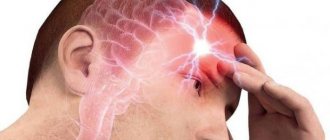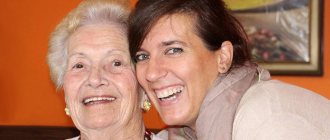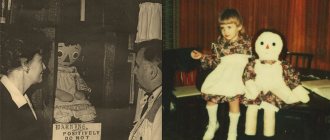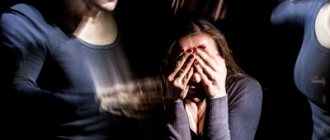Signs of vegetative-vascular dystonia are varied, in most cases they are a consequence of neurosis. VSD and neurosis are concomitant disorders; in addition, patients with VSD may experience mental disorders. Complex therapy allows you to eliminate the physiological and mental manifestations of the disease.
Effective treatment of neuroses and mental disorders in VSD is carried out by neurologists, psychotherapists, exercise therapy instructors and other specialists at the Yusupov Hospital, who use sound and safe methods of therapy.
VSD: astheno-neurotic syndrome
Modern experts believe that vegetative-vascular dystonia occurs as a result of stressful influences, as a result of which the functioning of the body’s systems is disrupted. Many people believe that neurosis and VSD are the same thing, but this opinion is erroneous. Various types of neuroses are common disorders that accompany VSD. However, most often when examining patients, astheno-neurotic syndrome is revealed.
When the nervous system is depleted in a person, astheno-neurotic syndrome is formed, the main manifestations of which are:
- emotional instability;
- high fatigue, which occurs even with minimal loads;
- drowsiness;
- feeling of weakness;
- cardiopalmus;
- trembling in the body.
Modern specialists use effective methods to restore normal functioning of the nervous system and neutralize the manifestations of VSD. When patients present with signs of impairment, the attending physician prescribes a comprehensive diagnosis to determine the degree of clinical manifestations and causes of the impairment. Based on the diagnostic results, methods are determined that need to be used as part of complex therapy.
The specialists at the Yusupov Hospital treat every patient with care. The coordinated work of the medical staff and other employees of the Yusupov Hospital is aimed at providing quality services in conditions of increased comfort.
Angioneurosis (Angiotrophoneurosis)
The clinical picture of most vegetative-vascular neuroses consists of painful paroxysms of vasoconstriction and/or dilatation. The duration of the attack varies from 2-3 minutes to several hours. The changes are local in nature, affecting one or more fingers, the auricle, nose, and sometimes the entire foot, hand, and face. Each disease is distinguished by certain characteristics of paroxysms and the course of the pathological process. Secondary angioneuroses are accompanied by symptoms characteristic of the underlying disease.
Raynaud's syndrome
accounts for 70-80% of all paroxysmal circulatory disorders of the extremities. It manifests itself as angiospastic episodes provoked by psycho-emotional stress, cold, and smoking. In a typical case, the changes cover the fourth and second fingers of the hands and feet, less often - the nose, outer ear, and chin. These parts of the body become cold and turn white. Patients complain of numbness, and then of burning and pain. During the interictal period, coldness, hyperhidrosis, and cyanotic toes and hands are noted.
Reil's disease
(dead finger syndrome) occurs with angiospastic paroxysms in the vessels of the fingers and sometimes the feet. Most often, an attack begins after cold exposure or a strong emotional experience. The affected finger suddenly becomes cold, deathly pale, and loses sensitivity. After paroxysm, the natural skin color, temperature and sensory sensations are restored.
Acrocyanosis
manifests itself as a cyanotic tint of the skin, symmetrically appearing in the distal parts of the extremities when they are lowered or exposed to cold. The moisture content of the skin and the pastiness of the tissues are determined. Elevating and warming the limb restores it to a healthy state.
Erythromelalgia
(Mitchell's disease) is characterized by angiodilation paroxysms with burning pain, hyperemia, and swelling. In most cases, changes occur in the big toe, less often in both feet at the same time. Possible damage to the hands, nose, ears, and female breasts. An erythromelalgic attack is provoked by compression (shoes, clothing, blanket), overheating, or hanging limbs. Between attacks, residual vascular changes persist and trophic disorders are observed.
Melkersson-Rosenthal disease
It is distinguished by the constancy of clinical manifestations and the localization of pathological changes within the facial area. Vascular dilatation is permanent and is accompanied by impaired blood outflow. The result is persistent swelling of the lips, cyanosis, swelling and folding of the tongue. Other parts of the face (eyelids, cheeks) are affected much less frequently. Angioneurosis is combined with neuritis of the facial nerve.
Rosacea
is expressed in constant hyperemia of the nose, cheeks, chin, forehead. In the area of redness, spider veins and erythematous rashes are found. Persistent expansion of the vascular network over time leads to swelling, roughness, and thickening of the skin. Possible damage to the paraorbital zone and eyelids.
Livedo
occurs due to the spastic-atonic state of the capillary network. It manifests itself as alternating pale and bluish areas of the skin, reminiscent of a marble pattern. The typical localization of livedo is the skin of the legs and thighs. The pathology is typical for young women.
Derealization in VSD
VSD and mental disorders can manifest themselves against the background of mental trauma, strong experiences and physical and nervous exhaustion. Some patients with VSD develop signs of mental disorders that do not allow them to lead a full life.
The feeling of unreality of what is happening during VSD or derealization is the brain’s reaction to stress. With this disorder, a person perceives the world around him as distant and unreal.
This disorder is different from panic attacks. The main signs of derealization are:
- perception of reality as unreal;
- changes in the perception of sounds, colors;
- feeling of weakness;
- increased blood pressure;
- fear of madness.
Against the background of these symptoms, the patient maintains adequate behavior and controls his actions. If signs of derealization appear, you must immediately consult your doctor who will prescribe treatment.
When treating derealization, it is necessary to get rid of bad habits and optimize time for rest and work. At the Yusupov Hospital, experienced psychotherapists interact with patients who have a feeling of unreality of what is happening with VSD, who use safe methods to eliminate depression and other manifestations of the disorder.
Causes
The development of autonomic neurosis is not caused by any single cause; it is usually the result of several factors:
- Traumatic brain injury with brain damage;
- Chronic fatigue, stress and depression;
- Consequences of certain infectious diseases;
- Wrong lifestyle;
- Mental and physical stress;
- Psychological trauma;
- Individual predisposition to neuroses.
Like many mental illnesses, this disorder often originates from a person’s childhood. Psychological trauma and shock experienced at an early age can develop into a serious illness after a few years. Moreover, not only people from disadvantaged families are susceptible to vegetative neurosis, but also ordinary children who lack the attention of their parents.
At an early age, monitoring the child’s psychological state is very important, since it is at this time that the foundation for adult life is laid. However, many parents, unfortunately, do not attach importance to this, accepting the child’s whims and tantrums as one of the manifestations of childhood.
When a person grows up, other factors influence his psycho-emotional state. Conflicts within the family, problems at work, social injustice - all this can cause autonomic neurosis.
Sometimes in adults, neurosis is caused by hormonal changes in the body, this is especially often observed in women during pregnancy. Also, the psychological state is affected by addiction to alcohol, drugs (and any poisoning in general), poor lifestyle or poor environment.
VSD with agoraphobia
Fears and panic attacks during VSD occur suddenly in patients. Agoraphobia is one of the defense mechanisms that manifests itself unconsciously. This condition is characterized by a person’s avoidance of open spaces. Experiences arise as a result of traumatic situations that are associated with surrounding people.
The development of agoraphobia is influenced by bad habits, mental illness, trauma received in childhood, and bad habits. The main symptoms of agoraphobia are:
- shallow breathing;
- cardiopalmus;
- tinnitus;
- skin redness;
- intense sweating;
- fear that people around will notice the attack;
- feeling of embarrassment;
- fear of going crazy;
- fear of death.
Patients come to the Yusupov Hospital who say that they seem to be going crazy from VSD; they have read reviews about this disorder online and thereby independently aggravate their condition. Agoraphobia also causes behavioral symptoms. The patient begins to avoid environments or circumstances that cause fear. He becomes more confident when surrounded by close people, for example, when going to the store with a relative.
Agoraphobia with VSD is treated at the Yusupov Hospital through regular sessions with a psychotherapist and taking medications. For drug treatment, tranquilizers and antidepressants are prescribed. These drugs have side effects, psychotherapists at the Yusupov Hospital select the safest drugs for patients.
Treatment of autonomic dystonia syndrome
There are several basic principles in the treatment of SVD:
- A complex approach. Doctors combine therapeutic methods of treatment: physiotherapy, drug therapy, herbal medicine, acupuncture, physical therapy, and so on.
- Individual approach. The disease is thoroughly studied, starting with the causes of its occurrence, the degree of development of symptoms and ending with the severity of the disease.
- Timely treatment. Vegetative dystonia syndrome is much easier to cure by consulting a doctor in a timely manner.
- Long-term treatment. It takes a lot of time to treat the consequences of SVD. And we are talking not so much about eliminating the symptoms that have appeared, but about complete recovery.
- Help for the whole family. Psychotherapeutic activities are carried out both with the sick child and with the parents.
In addition to drug methods of treating vegetative dystonia syndrome, non-drug methods are actively used. Medicines are used mainly for long-term VDS or severe disease. At the initial stage of the disease and in mild cases, experts prefer to use non-drug treatment. It should be supplemented by an adjusted lifestyle: sleep - 8-10 hours, daily walks in the fresh air - at least 2 hours a day, a maximum of 1.5 hours should be devoted to television and the computer, and parents should in every possible way protect the child from stress, create a environment around him pleasant microclimate.
It is necessary to strictly adhere to the prescribed diet. It is recommended to eat foods rich in magnesium and sodium salts: vegetables, fruits, legumes, cereals, and so on. In this case, sunflower oil must be replaced with olive oil.
Tea and coffee should be consumed only with milk, kefir and chocolate should be added to the daily diet, and foods with a high liquid content should be consumed as often as possible. The consumption of table salt should be reduced to a minimum in cases with hypertensive syndrome of vegetative dystonia, and beans, cottage cheese, milk, salads, spinach, carrots, and barley porridge should be added to the diet. In the cardiac form of SVD, any food that has a beneficial effect on the properties of the blood is relevant: a moderate amount of spices, vegetable oil, citrus fruits, gray porridge, and so on.
Regardless of the type of disease, honey (for 2-3 months before bedtime), compote of sea buckthorn, cranberries, rowan berries, rose hips, apricots, raisins, dried apricots, lingonberries, various fruit and vegetable juices, infusions and mineral waters are mandatory for consumption. .
Under no circumstances should you be freed from physical activity. Physical education and sports help in the treatment of all forms of SVD, with the exception of diseases that have reached a crisis. In the event of a crisis, it is necessary to engage exclusively in therapeutic exercises. In other cases, running and walking, cycling, skating, swimming, hiking, and skiing help well. A massage of the spine and cervical-collar area (up to 20 sessions) will not be amiss.
The hypotensive form of SVD involves active physical activity and active sports: tennis, shaping, dancing, and so on. In the treatment of cardiac autonomic dystonia syndrome, badminton, swimming and jogging are recommended. The hypertensive type of SVD limits the patient only to swimming, walking and hiking. For any type of disease, it is not recommended to engage in team sports such as basketball, football, handball, volleyball and so on.
Experts agree that physiotherapeutic treatment methods are more than successful. These include treatment with ultrasound, sinusoidal modulated currents, inductometry, electrosleep, electrophoresis of drugs and other methods of similar action. Mixed type vegetative dystonia syndrome is preferably treated with electrophoresis of drugs using one of the methods: either endonasal electrophoresis of a solution of novocaine (2%), or a 1% solution of novocaine in combination with a 0.2% solution of potassium iodide. For sympathicotonia, electrophoresis with a 0.5% solution of aminophylline, magnesium sulfate, papaverine, and bromine is recommended. For vagotonia, the most relevant is electrophoresis with caffeine, mesatone, and calcium. These procedures are carried out every two days for 20-30 days. If necessary, the course of treatment can be repeated after 1-2 months.
Treatment with medications is usually started either in combination with the above methods or after their use has ended. It is preferable to start drug treatment of vegetative dystonia syndrome with common drugs (Zamanikha, bromine, valerian) that have a minimal number of side effects. Drugs and their dosage are prescribed taking into account the individual characteristics of the patient’s body. Age plays a big role in choosing the dosage of medications. Since the duration of treatment for vegetative dystonia syndrome is long-term, drugs are prescribed gradually and often replace each other.
Part of the therapy consists of antipsychotics and tranquilizers that have a sedative effect. The former can significantly reduce the reaction to various external stimuli. Neuroleptics for children are selected from the most “light” ones, which are well tolerated when tranquilizers have shown their ineffectiveness. Sonopax (10-30 mg per day depending on age), frenolone (about 10 mg per day), Terolene (about 10 mg per day) are prescribed. These drugs can be combined.
Tranquilizers help cope with insomnia, fear, panic, and are a good remedy for cardialgia and extrasystole.
For vagotonia, amizil is recommended (about 2 mg per day). Hypersympathicotonic reactivity and sympathicotonia become the reason for the prescription of tazepam (20-30 mg per day), seduxen (about 10 mg per day). These drugs are not recommended for use in children with a tendency to hypotension, as well as in the presence of initial vagotonic tone. For mixed vegetative dystonia syndrome, bellaspon and belloid (1-3 tablets per day), phenibut (0.25-0.5 mg per day), meprobamate (0.3-0.7 mg per day). As a rule, tranquilizers in childhood are prescribed in the lowest possible doses. Over time, the dosage of the drugs is gradually increased. Treatment with small doses of tranquilizers is necessary for at least 2 months, and it is best to take the drugs in the evening or after lunch.
The further course of treatment with medications is prescribed individually and directly depends on the type of dystonia. For arterial hypertensia, sedative herbal preparations are prescribed; antispasmodic medications are used less frequently. ACE inhibitors and calcium antagonists are often prescribed, which are highly effective and have minimal possible side effects. If the effectiveness of these drugs individually is minimal, the doctor may prescribe a combination of drugs.
Rhodiola, eleutherococcus extract, tinctures of aralia, zamanika, ginseng, lemongrass, as well as other herbal psychostimulants are prescribed for arterial hypotension, which is quite severe.
Neurometabolic drugs are most relevant in childhood in the presence of autonomic dystonia syndrome with changes in the functioning of the central nervous system. Pyridoxal phosphate is prescribed for vagotonia; vitamins B4 and E in combination with potassium preparations - for sympathicotonia, and to increase the level of microcirculation - stugeron, cavinton, trental.
Drug treatment of almost all types of SVD also includes the use of herbal dietary supplements with vitamins, microelements and coenzymes.
Does psychotherapy help with VSD?
A psychotherapist for VSD affects the psycho-emotional sphere using various methods. In most cases, after treatment for neuroses and psychological disorders associated with VSD, complete recovery occurs. During sessions, psychotherapists teach techniques to curb the manifestation of derealization and agoraphobia.
Psychotherapists use structured techniques to help relieve the patient from the manifestation of these disorders. During sessions, the patient can trust the specialist and talk about his experiences. If you need advice from a psychotherapist or other clinic specialists on the treatment and diagnosis of VSD and its manifestations, make an appointment by calling the Yusupov Hospital.
Symptoms
Autonomic neurosis has many symptoms - and this, on the contrary, makes it difficult to diagnose. The most pronounced signs of diseases of the genitourinary, cardiovascular and digestive systems of the body. In addition, the patient may experience severe headaches and sudden changes in blood pressure; pain in muscles and joints is even less common.
Other symptoms include chronic fatigue, which does not go away even in the absence of high physical activity and good rest. People suffering from autonomic neurosis get tired quickly, do not tolerate sharp sounds well, and often become irritated at the slightest provocation. This condition is isolated into a separate disease, which is called asthenic syndrome.
In addition, autonomic neurosis is distinguished by several signs that usually do not correspond to most diseases:
- Deterioration of the condition of the skin, hair and nails; muscle atrophy, the appearance of trophic ulcers;
- Changes in the skin: increased secretion of sweat and sebum, peeling, appearance of age spots, etc.;
- Periodic stool disorders, lack of oxygen, disturbances in the functioning of the gallbladder;
- Various allergic reactions;
- Hypochondria, which is characterized by increased suspiciousness and suspicion of illness, as well as fear at the slightest ailment;
- Fears without any reason, and patients realize their groundlessness, but cannot resist them.
Disturbances in the functioning of the heart muscle, indicating autonomic neurosis, cannot be treated with medications, since they are not caused by diseases of the internal organs. Such pains are called false. Despite the fact that they do not talk about heart disease, their occurrence is very unpleasant and painful for a person. The same applies to pathologies of other organs and systems.
Get advice anonymously and free of charge
Our specialist will call you within 5 minutes, leave a request
If you feel pain in one or another part of your body, do not self-medicate. It is possible that your organs are healthy, and with your medications you will harm the body. To determine the cause of the pain, consult a doctor.
Signs of autonomic neurosis in most cases do not appear individually. To accurately diagnose the disease, the doctor must conduct a comprehensive examination of the patient. Only after receiving the results of all tests and observations can appropriate treatment be selected.
What lies behind the terms neurosis and psychosis?
We are so used to throwing around the words “hysterical”, “neurasthenic”, “psychopath” that we often forget that we use medical terms as curses or even ridicule. Meanwhile, there is nothing funny in these words.
Neurosis
Neurosis can be briefly described as follows:
- This is nervous exhaustion, a long-term chronic disorder that can develop in a person against the background of stress or a traumatic event.
- The personality of a patient suffering from neurosis usually does not undergo major changes. The person maintains a critical attitude towards the disease; he can control his behavior.
- As a rule, neurosis is manifested by vegetative, somatic and affective disorders.
- This is a reversible (curable) disease.
The most common types of this disease are:
- neurasthenia (asthenic neurosis, fatigue syndrome);
- hysteria (hysterical neurosis);
- various phobias (fears, panic attacks) and obsessive states (obsessive neurosis).
One of the main reasons for the formation of neurosis is stress in the broadest sense of the word, be it a childhood trauma, an unfavorable climate in the family, a crisis at work, nervous strain, interpersonal conflict or emotional shock.
According to medical statistics, the state of neurosis is familiar firsthand to 10-20% of the population of our planet, and approximately 5% of the world's inhabitants suffer from various types of psychosis.
Psychosis
Speaking about psychosis, it is necessary to note the following:
- This is a mental disorder characterized by inappropriate human behavior and an atypical reaction to events and phenomena.
- It manifests itself as mental disorders, in particular, disturbances in the perception of reality (hallucinations, delusions).
- It develops unnoticed by the patient and may be a consequence of pathologies of the endocrine and nervous systems.
- Capable of completely changing the patient's personality.
- This is a difficult to cure disease.
Psychoses according to their origin are usually divided into:
- Endogenous , that is, associated with internal causes (somatic diseases, hereditary mental disorders, age);
- Exoorganic , caused by external factors (infections, intoxication, etc.) or associated directly with a violation of the structure of the brain (trauma, hemorrhage, neoplasms, etc.).
The first group includes:
- affective insanity;
- senile (senile);
- affective;
- schizophrenic;
- epileptic;
- symptomatic psychosis, etc.
The exogenous group includes:
- reactive acute psychosis;
- intoxication;
- infectious;
- alcoholic psychosis, etc.
1 Biofeedback therapy in the treatment and diagnosis of psychosis
2 Biofeedback therapy in the treatment and diagnosis of psychosis
3 Biofeedback therapy in the treatment and diagnosis of psychosis








